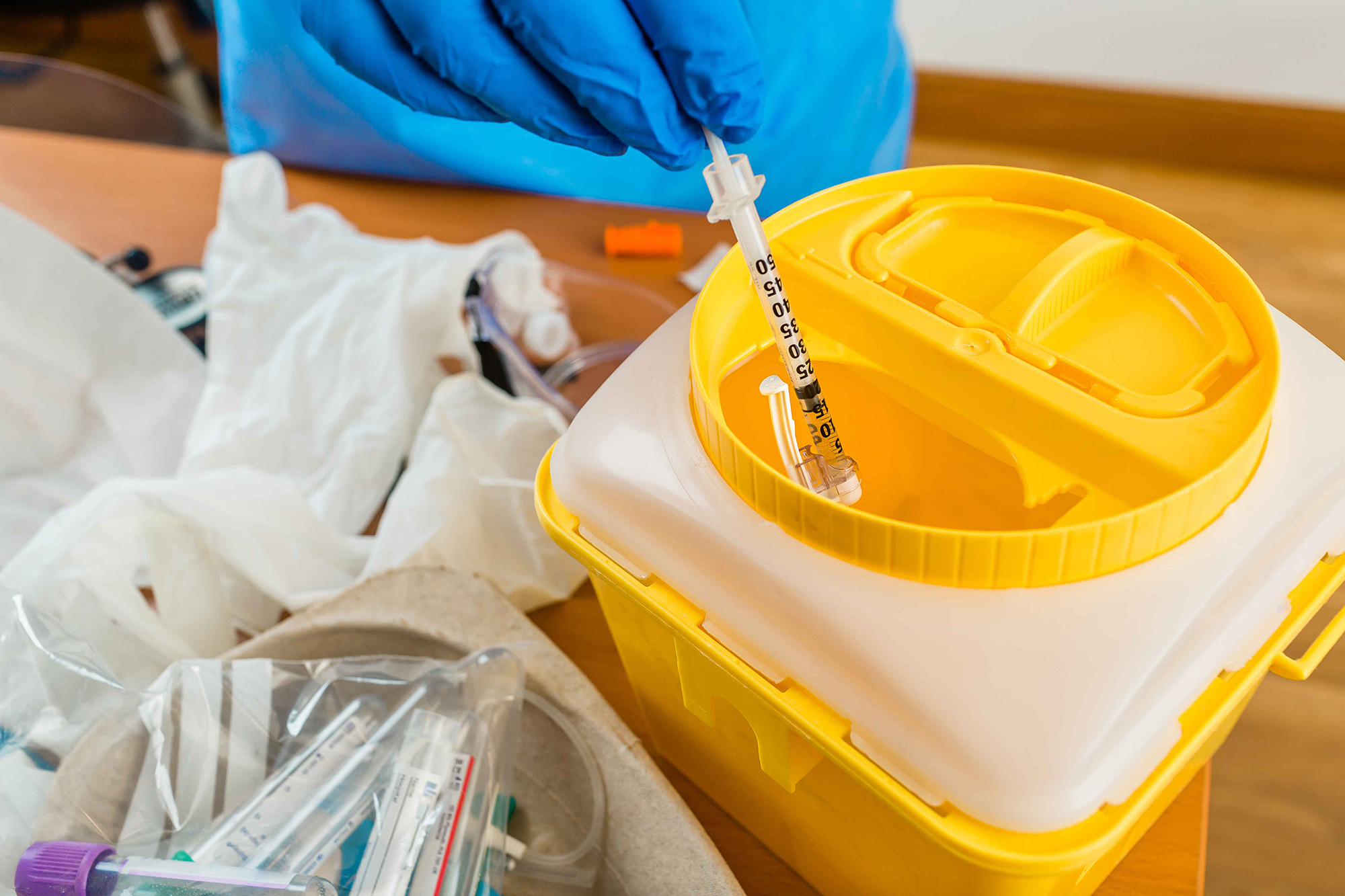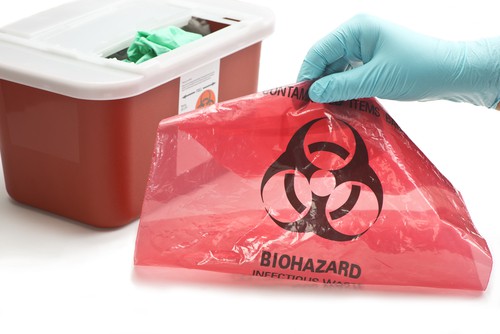Ideal Practices for Medical Waste Administration
Clinical waste monitoring is an important element of medical care centers' procedures to guarantee the security of clients, staff, and the atmosphere. Carrying out finest methods in clinical waste monitoring is important to minimize the threats linked with hazardous waste.

Partition and Categorization
In the area of medical waste administration, proper segregation and classification are crucial techniques for ensuring the secure and reliable disposal of healthcare-related products. Clinical waste is generated from numerous resources, consisting of health centers, centers, labs, and other health care centers. It contains a large array of products, such as needles, syringes, bandages, handwear covers, and pharmaceutical waste.
Segregation includes the organized splitting up of various kinds of medical waste based on their features and potential dangers. Sharps waste, such as blades and needles, ought to be placed in puncture-resistant containers to stop injuries and the spread of contagious illness.
Classification is the procedure of identifying medical waste right into different categories based on its possible hazards. These classifications may include contagious waste, unsafe waste, pharmaceutical waste, and general waste. By classifying waste, health care centers can identify the proper disposal approaches and make sure compliance with regional policies and standards.
Proper segregation and categorization of clinical waste not only safeguard the health and wellness and security of medical care workers and the basic public but additionally add to the general performance and efficiency of waste management. It minimizes the threat of crashes, minimizes ecological impacts, and promotes accountable waste disposal techniques.
Proper Storage and Labeling
To make sure the secure and effective disposal of clinical waste, health care facilities should stick to correct storage and labeling practices. WasteX Medical Waste Disposal. Proper storage space and labeling play an essential duty in preserving the integrity of clinical waste administration systems and safeguarding the health and wellness of medical care employees, clients, and the public
When it involves storage, it is important to have actually designated locations specifically created for various sorts of medical waste. These locations ought to be protected, well-ventilated, and furnished with appropriate containers that satisfy regulative standards (medical waste removal). Partition and classification of waste should additionally be taken into account to avoid cross-contamination and potential risks

Routine surveillance and inspection of storage areas and containers are vital to recognize any issues or violations. Staff must be educated on correct storage and labeling practices, emphasizing the relevance of conformity with regulations and protocols.
Safe Transportation and Handling
Making sure the protected and proper transportation and handling of clinical waste is important for maintaining the stability of waste monitoring systems and safeguarding the wellness and security of all involved. Medical waste, that includes products infected with infectious products, pharmaceuticals, and other dangerous materials, must be transported in a manner that stops leaks, spills, and prospective contamination.
It is vital to make use of watertight and puncture-resistant containers that are particularly designed for medical waste. Furthermore, waste needs to be segregated based on its nature and type to protect against cross-contamination.
Throughout transportation, it is essential to make sure that waste containers are firmly fastened and stored in a secure way. Vehicles utilized for carrying clinical waste ought to be outfitted with appropriate safety features, such as spill control systems, to decrease the risk of any spills or leaks. Chauffeurs must obtain training on correct handling and emergency situation reaction treatments to efficiently attend to any type of unforeseen occurrences.
Additionally, the transportation and handling of clinical waste ought to abide by all pertinent policies and guidelines established forth by local, state, and government authorities. WasteX Medical Waste Disposal. medical waste disposal service. Routine examinations and audits need to be performed to analyze conformity and identify any areas for renovation
Conformity With Regulatory Guidelines
Preserving compliance with regulatory guidelines is essential for reliable clinical waste monitoring. These guidelines are established to protect public health and the atmosphere by guaranteeing that clinical waste is appropriately handled, treated, and disposed of. Compliance with governing standards helps to avoid the spread of infectious illness, minimize potential risks, and lower the overall impact of clinical waste on the environment.
To achieve compliance, healthcare centers should remain informed regarding the specific laws regulating clinical waste administration in their territory. These policies may differ from nation to country, and even within different states or areas. It is necessary for medical care facilities to have a comprehensive understanding of these guidelines and to apply ideal approaches and procedures to ensure compliance.
One trick aspect of compliance is the appropriate partition and labeling of various sorts of medical waste. This consists of separating sharps from various other waste, as well as categorizing waste based on its prospective risks. Healthcare centers should also make certain that clinical waste is stored in proper containers and that these containers are correctly labeled and sealed.
Furthermore, conformity with governing guidelines calls for healthcare facilities to develop proper training and education programs for team member involved in medical waste management. This consists of providing training on waste segregation, managing, and disposal treatments, along with the correct use individual protective equipment.
Routine surveillance and audits are likewise vital to make sure recurring conformity with regulatory standards. This includes conducting regular evaluations of waste storage space locations, documenting waste management procedures, and maintaining records of garbage disposal.
Efficient Disposal Techniques
Medical care centers must use efficient disposal approaches for correct administration of medical waste. Improper disposal of medical waste can pose severe health and ecological risks. There are a number of techniques that can be used to effectively get rid of medical waste, making sure the security of medical care employees, patients, and the basic public.
One frequently used method is incineration. Incinerators can securely melt medical waste at heats, minimizing the quantity and damaging any type of possibly unsafe microorganisms. Nevertheless, incineration can be expensive and might release dangerous pollutants right into the air if not effectively regulated.
An additional technique is autoclaving, which involves subjecting the waste to high-pressure heavy steam. This process kills bacteria, infections, and other microbes, rendering the waste safe for disposal in normal waste streams. Autoclaving is a eco friendly and efficient method, however it needs customized devices and trained employees.
Chemical sanitation is additionally used in many cases, where fluid chemicals are put on the waste to sanitize it. This technique is much less frequently made use of due to worries concerning the efficiency of chemical sanitation and the possibility for chemical deposits to pollute the environment.
In enhancement to these methods, health care facilities need to additionally execute appropriate partition, product packaging, and labeling of medical waste to guarantee its risk-free handling and disposal. Regular training and education and learning this hyperlink of staff on correct waste management methods are vital to preserving efficient disposal techniques.
Final Thought
Finally, executing finest methods for clinical waste administration is vital for ensuring the safety of medical care employees, individuals, and the atmosphere. By correctly categorizing and segregating waste, keeping and labeling it appropriately, guaranteeing safe transportation and handling, abiding by governing standards, and using reliable disposal approaches, medical care centers can effectively take care of and lessen the threats linked with clinical waste. It is crucial for healthcare companies to focus on and stick to these finest techniques to keep a secure and lasting healthcare setting.
Clinical waste management is a crucial aspect of medical care centers' operations to ensure the safety of clients, team, and the atmosphere. Applying finest techniques in medical waste management is essential to decrease the threats connected with dangerous waste. These groups may consist of contagious waste, harmful waste, pharmaceutical waste, and general waste.In conclusion, executing best techniques for clinical waste management is important for making certain the safety and security of health care workers, clients, and the setting. By appropriately segregating and classifying waste, storing and labeling it appropriately, ensuring risk-free transport and handling, abiding with regulative guidelines, and utilizing reliable disposal methods, healthcare facilities can successfully handle and decrease the risks connected with clinical waste.